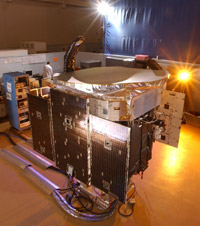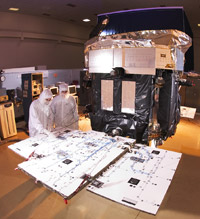CloudSat

Overview
CloudSat is a mission designed to study the effects of clouds on climate and weather. With capabilities 1,000 times more sensitive than typical weather radar, CloudSat uses millimeter-wavelength radar to measure the altitude and properties of clouds. This information will provide the first global measurements of cloud properties that will help scientists compile a database of cloud measurements, aiding in global climate and weather prediction models.
Our Role
Ball Aerospace built the CloudSat spacecraft and tested and integrated the
Cloud Profiling Radar payload, built by NASA's Jet Propulsion
Laboratory. Other hardware contributions from the Canadian Space Agency
were also tested and integrated by Ball Aerospace. Colorado State University
provides science data processing and distribution.

CloudSat launched with CALIPSO into a polar orbit at an altitude of 438 miles (705 km). Both spacecraft are part of a constellation of spacecraft called the "A-Train," including Aqua, Aura and PARASOL, dedicated to studying the Earth’s weather and environment. CloudSat and CALIPSO launched April 28, 2006 from Vandenberg Air Force Base.
The Ball Aerospace CloudSat team was awarded NASA's Group Achievement Award for outstanding achievement in the design, development, assembly, integration, test, launch, and early orbit operations of the CloudSat spacecraft.
